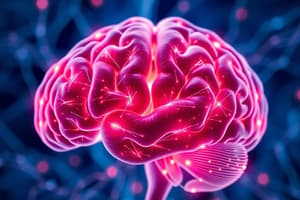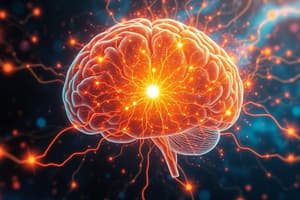Podcast
Questions and Answers
What is the primary function of the occipital lobes?
What is the primary function of the occipital lobes?
- Recognizing and interpreting visual information (correct)
- Processing sensory information from the body
- Controlling body temperature
- Regulating emotions
Which part of the brain is primarily responsible for processing sensory information and spatial orientation?
Which part of the brain is primarily responsible for processing sensory information and spatial orientation?
- Parietal lobes (correct)
- Cerebellum
- Thalamus
- Cerebrum
Which part of the brain serves as the main control center for vital functions like heartbeat and respiration?
Which part of the brain serves as the main control center for vital functions like heartbeat and respiration?
- Thalamus
- Limbic system
- Brain stem (correct)
- Cerebellum
What is the primary role of the limbic system?
What is the primary role of the limbic system?
What function does the hypothalamus perform?
What function does the hypothalamus perform?
Which brain structure is critical for converting information from working memory to long-term storage?
Which brain structure is critical for converting information from working memory to long-term storage?
What is one main function of the amygdala?
What is one main function of the amygdala?
Which part of the brain is the largest and responsible for thinking and memory?
Which part of the brain is the largest and responsible for thinking and memory?
What is the primary difference between emotions and feelings?
What is the primary difference between emotions and feelings?
According to the Cannon-Bard Theory of Emotion, emotions
According to the Cannon-Bard Theory of Emotion, emotions
Which dimension relates to the intensity of the feeling?
Which dimension relates to the intensity of the feeling?
What is a characteristic of emotions according to the provided content?
What is a characteristic of emotions according to the provided content?
Which of the following does NOT represent a dimension of feelings?
Which of the following does NOT represent a dimension of feelings?
The Schachter-Singer Two-Factor Theory of Emotion emphasizes the importance of
The Schachter-Singer Two-Factor Theory of Emotion emphasizes the importance of
Which theory suggests that emotions follow from bodily sensations?
Which theory suggests that emotions follow from bodily sensations?
Which statement best describes the role of feelings?
Which statement best describes the role of feelings?
What primarily influences a student's self-efficacy?
What primarily influences a student's self-efficacy?
Which aspect of self-concept reflects how much an individual values themselves?
Which aspect of self-concept reflects how much an individual values themselves?
How does a person with a growth mindset typically view failure?
How does a person with a growth mindset typically view failure?
What distinguishes a fixed mindset from a growth mindset?
What distinguishes a fixed mindset from a growth mindset?
What can help a student interpret physiological responses positively before a presentation?
What can help a student interpret physiological responses positively before a presentation?
What does 'ideal self' refer to in the context of self-concept?
What does 'ideal self' refer to in the context of self-concept?
In Dweck's theory, which mindset likely leads to greater resilience in the face of setbacks?
In Dweck's theory, which mindset likely leads to greater resilience in the face of setbacks?
What physiological reactions might a student experience before giving a presentation?
What physiological reactions might a student experience before giving a presentation?
What is meant by self-efficacy?
What is meant by self-efficacy?
How do learners monitor their performance effectively?
How do learners monitor their performance effectively?
Which of these is NOT a source of self-efficacy according to Bandura?
Which of these is NOT a source of self-efficacy according to Bandura?
What role do verbal persuasions play in self-efficacy?
What role do verbal persuasions play in self-efficacy?
In the context of self-efficacy, what is the significance of vicarious experiences?
In the context of self-efficacy, what is the significance of vicarious experiences?
Which phase involves learners evaluating their performance against established goals?
Which phase involves learners evaluating their performance against established goals?
What is a key outcome of setting goals in learning?
What is a key outcome of setting goals in learning?
How can positive past experiences affect self-efficacy?
How can positive past experiences affect self-efficacy?
What term describes stress that is positive and beneficial?
What term describes stress that is positive and beneficial?
Which type of stress is characterized as neutral or having no significant impact?
Which type of stress is characterized as neutral or having no significant impact?
What is the first step in how the body reacts to stress?
What is the first step in how the body reacts to stress?
During which stage does the body prepare to face a perceived threat?
During which stage does the body prepare to face a perceived threat?
What is the primary action taken during the 'Response' stage to stress?
What is the primary action taken during the 'Response' stage to stress?
What is the final stage where the body returns to a calm state called?
What is the final stage where the body returns to a calm state called?
How can culture influence the stress response according to research?
How can culture influence the stress response according to research?
Which of the following best illustrates 'Distress'?
Which of the following best illustrates 'Distress'?
How does the trait 'Hiya' differ in perception between Western and Oriental cultures?
How does the trait 'Hiya' differ in perception between Western and Oriental cultures?
What does 'Pakikisama' signify according to the Oriental view?
What does 'Pakikisama' signify according to the Oriental view?
Which type of suicide is characterized by a breakdown in social norms?
Which type of suicide is characterized by a breakdown in social norms?
How is 'Bahala na' interpreted negatively in the Western view?
How is 'Bahala na' interpreted negatively in the Western view?
What type of coping strategy focuses on directly addressing the source of stress?
What type of coping strategy focuses on directly addressing the source of stress?
In which context is the trait 'Kanya-kanya' viewed positively?
In which context is the trait 'Kanya-kanya' viewed positively?
What does the Western concept of 'Ningas cogon' suggest?
What does the Western concept of 'Ningas cogon' suggest?
How do Western cultures perceive the concept of 'Saving face'?
How do Western cultures perceive the concept of 'Saving face'?
What is the main focus of emotion-focused coping?
What is the main focus of emotion-focused coping?
Why is 'Utang na loob' viewed negatively in the Western context?
Why is 'Utang na loob' viewed negatively in the Western context?
In the context of Filipino values, what does 'Bukas na (Mañana habit)' imply in Oriental views?
In the context of Filipino values, what does 'Bukas na (Mañana habit)' imply in Oriental views?
What does 'Patigasan' symbolize positively in Oriental culture?
What does 'Patigasan' symbolize positively in Oriental culture?
In terms of Maslow’s Hierarchy of Needs, what is essential for motivation?
In terms of Maslow’s Hierarchy of Needs, what is essential for motivation?
Flashcards
Pleasantness-unpleasantness dimension
Pleasantness-unpleasantness dimension
Describes feelings as either positive or negative.
Excitement-numbness dimension
Excitement-numbness dimension
Indicates the intensity of a feeling.
Tension-relaxation dimension
Tension-relaxation dimension
Refers to how a feeling affects the body's energy level.
Emotions vs. Feelings
Emotions vs. Feelings
Signup and view all the flashcards
James-Lange Theory
James-Lange Theory
Signup and view all the flashcards
Cannon-Bard Theory
Cannon-Bard Theory
Signup and view all the flashcards
Schachter-Singer Two-Factor Theory
Schachter-Singer Two-Factor Theory
Signup and view all the flashcards
Emotion
Emotion
Signup and view all the flashcards
Occipital Lobes Function
Occipital Lobes Function
Signup and view all the flashcards
Parietal Lobes Role
Parietal Lobes Role
Signup and view all the flashcards
Brain Stem Function
Brain Stem Function
Signup and view all the flashcards
Limbic System Purpose
Limbic System Purpose
Signup and view all the flashcards
Thalamus's Job
Thalamus's Job
Signup and view all the flashcards
Hypothalamus's Function
Hypothalamus's Function
Signup and view all the flashcards
Hippocampus's Role
Hippocampus's Role
Signup and view all the flashcards
Amygdala's Action
Amygdala's Action
Signup and view all the flashcards
Self-Efficacy
Self-Efficacy
Signup and view all the flashcards
Enactive Mastery Experiences
Enactive Mastery Experiences
Signup and view all the flashcards
Vicarious Experiences
Vicarious Experiences
Signup and view all the flashcards
Verbal Persuasion
Verbal Persuasion
Signup and view all the flashcards
Self-Reflection
Self-Reflection
Signup and view all the flashcards
Setting Goals
Setting Goals
Signup and view all the flashcards
Social Learning Theory
Social Learning Theory
Signup and view all the flashcards
Monitoring Performance
Monitoring Performance
Signup and view all the flashcards
Sources of self-efficacy
Sources of self-efficacy
Signup and view all the flashcards
Emotional state and self-efficacy
Emotional state and self-efficacy
Signup and view all the flashcards
Self-concept
Self-concept
Signup and view all the flashcards
Ideal self
Ideal self
Signup and view all the flashcards
Self-image
Self-image
Signup and view all the flashcards
Self-esteem
Self-esteem
Signup and view all the flashcards
Growth mindset
Growth mindset
Signup and view all the flashcards
What is stress?
What is stress?
Signup and view all the flashcards
Eustress
Eustress
Signup and view all the flashcards
Distress
Distress
Signup and view all the flashcards
Stress Response Stages
Stress Response Stages
Signup and view all the flashcards
Fight or Flight Response
Fight or Flight Response
Signup and view all the flashcards
Stress and Culture
Stress and Culture
Signup and view all the flashcards
Coping Processes
Coping Processes
Signup and view all the flashcards
Cultural Influence on Stress
Cultural Influence on Stress
Signup and view all the flashcards
Hiya (Filipino Trait)
Hiya (Filipino Trait)
Signup and view all the flashcards
Ningas Cogon (Filipino Trait)
Ningas Cogon (Filipino Trait)
Signup and view all the flashcards
Pakikisama (Filipino Trait)
Pakikisama (Filipino Trait)
Signup and view all the flashcards
Patigasan (Filipino Trait)
Patigasan (Filipino Trait)
Signup and view all the flashcards
Bahala Na (Filipino Trait)
Bahala Na (Filipino Trait)
Signup and view all the flashcards
Kasi (Filipino Trait)
Kasi (Filipino Trait)
Signup and view all the flashcards
Saving Face (Filipino Trait)
Saving Face (Filipino Trait)
Signup and view all the flashcards
Sakop (Filipino Trait)
Sakop (Filipino Trait)
Signup and view all the flashcards
Bukas Na (Mañana Habit) (Filipino Trait)
Bukas Na (Mañana Habit) (Filipino Trait)
Signup and view all the flashcards
Utang na Loob (Filipino Trait)
Utang na Loob (Filipino Trait)
Signup and view all the flashcards
Kanya-Kanya (Filipino Trait)
Kanya-Kanya (Filipino Trait)
Signup and view all the flashcards
Egoistic Suicide (Durkheim)
Egoistic Suicide (Durkheim)
Signup and view all the flashcards
Altruistic Suicide (Durkheim)
Altruistic Suicide (Durkheim)
Signup and view all the flashcards
Anomic Suicide (Durkheim)
Anomic Suicide (Durkheim)
Signup and view all the flashcards




